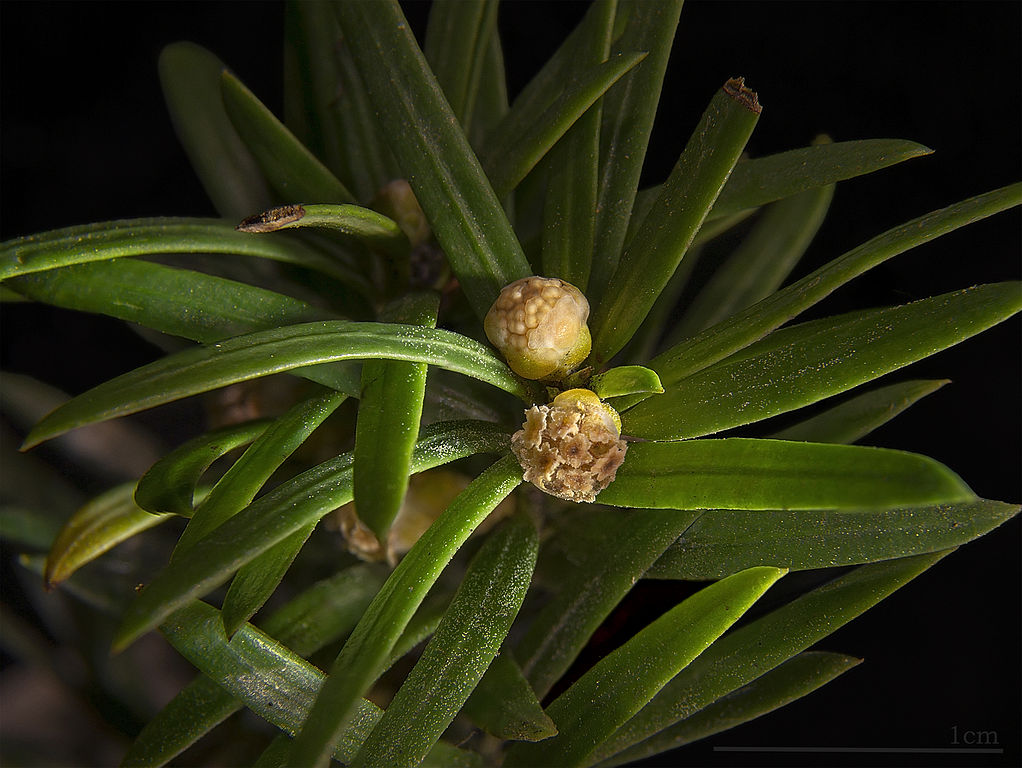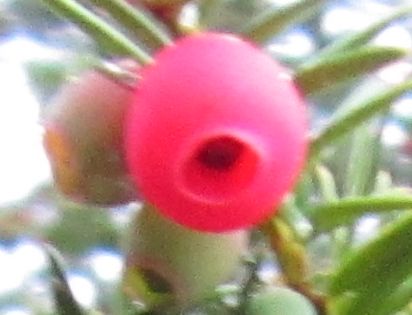Nature's Restaurant:
Fields, Forests & Wetlands Foods of Eastern North America
A Complete Wild Food Guide
Search Nature's Restaurant & Wild Foods Home Garden Websites:
Yew Berries

Ripe, red Yew fruit with unripe, green berries. Never eat a green or partly green berry. (By: Frank Vincentz GNU Free Documentation License, Version 1.2)
Season: Late Summer & Early Fall
Urban, Rural or Both: Both
Yew Berries (Taxus baccata), Taxus. The red flesh of the ripe berries is safe and sweet tasting, though without any great flavor, but the seed in the center of the red berry is deadly poisonous, and the rest of the tree is deadly poisonous. Though there are different species of the Taxus, I give the description of the Taxus baccata, but most are basically the same, and in fact, many taxonomists consider them all just variations of one tree, and use the name Taxus baccata to cover the whole group.
Please teach young children to consider these trees poisonous including the ripe berry, and don't eat them in front of young children.
Despite what you might read on the Internet, do not use any other parts of the plants for medicinal purposes. I've read some stuff that is very confused, wrong and dangerous. Only the flesh of the ripe berry is safe, and even then, extreme caution must be taken to not eat the seeds
The red fleshy part you eat is called an Aril. Though it seems when looking at the Yew Berry, the part you eat is a fruit, it is not. These Arils are often called false-fruits. In fact, with the Yew, the red flesh is actually the conifer's cone scale just altered to be an edible enticement for animals (birds mainly) to eat the Yew Berry and pass the seed out the other end when they have moved on, thus spreading the seed over distance. When I say cone scale, think of the scales on a Pine cone - the Yew Berry's red flesh is actually an altered cone scale!
When the berry is bright red - don't even think about eating the green ones - only eat one berry at a time. Do not put more than one at a time in your mouth, as this only increases the chances you will slip up and eat a seed. Use your tongue, not teeth, to remove the flesh from the berry, then before swallowing the flesh of the fruit, get the seed out of your mouth. Then move onto another berry. Only have one the first time you eat them, just to see if you are allergic. The reason you use your tongue, is that the seed in the berry, if whole and uncracked, might pass through your system undigested if you slip up and swallow one. If you were to bite on the seed, crack it and then accidentally swallow it - you're in trouble (if you do this, make yourself throw up right away). So by using your tongue, and eating one at a time to ensure you don't swallow, you are doubling your chances of not harming yourself.
Eating these berries - even if you are not allergic - causes the sensation of being very thirsty after about 15 to 30 minutes. Of course, the more you eat, the more noticeable this is.
Growing this plant in your home garden:
For detailed growing instructions, go to my Wild Foods Home Garden website Yew page.
Below is a list of the types of Yew trees you can encounter in Eastern North America:
- Yew, English Yew or European Yew (Taxus baccata).
- Canadian Yew (Taxus canadensis).
- Japanese Yew or Spreading Yew (Taxus cuspidata).
- Florida Yew (Taxus floridana).
Description:
- Plant Size: Generally up to 20 meters (65 feet), but some Yews can reach 40 meters (130 feet) high
- Duration: Very long lived tree - oldest in Scotland is apparently about 2000 years old
- Leaf Shape: Lanceolate, flat, "evergreen needle"
- Leaf Phyllotaxis (Leaf Arrangement) on branch: Spiral - each leaf is attached to the stem like stair steps attached to a central pole on a spiral staircase, however due to how the leaf stems twist, it appears without careful examination that there are two rows of leaves.
- Leaf Size: 1-4 cm long and 2-3 mm wide
- Leaf Margin: Entire (smooth edged)
- Leaf Notes: Leaves are dark green and soft feeling. Leaves are very toxic.
- Flowers: Small creamy white to yellowish flowers coming from leaf axils
- Fruit: 8-15 mm diameter bright red, generally spherical (some species slightly oval), with translucent quality when ripe, green when unripe. Hole in bottom of flesh of fruit revealing the seed in the middle. Green fruit is toxic, red ripe fruit is sweet and edible but without a lot of flavor.
- Bark: Thin, brown with a scaly quality, often partially peeling. On older trunks, peeling sections of reddish bark and sections of grey bark.
- Habitat: The Taxus baccata prefers soils that are slightly alkaline, while Taxus in general can be found in a very wide range of habitats. Most often found in Eastern North America as a planted ornamental.
- Recipe search on the web here (Google search) and here (Bing search).
- Pictures on the web here (Google images) and here (Bing images).
- USDA distribution map and plant profile for all Taxus in North America here.
- The Biota of North America Program (BONAP) distribution map here. BONAP map color key here.

Yew (Taxus) range. Distribution map courtesy of U. S. Department of Agriculture (USDA Natural Resources Service) and used in accordance with their policies.

Canada yew (Taxus canadensis) range. Distribution map courtesy of the USGS Geosciences and Environmental Change Science Center, originally from "Atlas of United States Trees" by Elbert L. Little, Jr. .

Illustration of the Taxus baccata. (By: Prof. Dr. Otto Wilhelm Thomé; Flora von Deutschland, Österreich und der Schweiz 1885, Gera, Germany)

Ripe Yew Berries. (By: Frank Vincentz GNU Free Documentation License, Version 1.2)

Male flower of the Taxus baccata. (By: Didier Descouens Attribution-Share Alike 4.0 International license)

Notice how the bottom of the Aril (The red fleshy part of the Yew berry) is a round hollow up to the inner seed. There is one ripe one and some unripe ones in behind. Don't even think about eating green ones.
Search Nature's Restaurant & Wild Foods Home Garden Websites:
Why does this site have ads?
Originally the content in this site was a book that was sold through Amazon worldwide. However, I wanted the information to available to everyone free of charge, so I made this website. The ads on the site help cover the cost of maintaining the site and keeping it available.
Website Information:
This website was designed and written by me in HTML using the Bluefish 2.2.7 editor on Mint 18 Cinnamon Linux. I used the Bootstrap frontend framework, style sheets & Javascript.
This site is hosted by HostUpon. I am very thankful to them for all the patient technical support I received when I first set up my websites and had no idea what I was doing. I am happy to recommend them.
The site is designed to work with all browsers and is specifically designed to be highly functional on smartphones. I kept the site simple, with a clean page design to make using on a smartphone easy, quick & efficient. The Bootstrap framework is responsive, and automatically scales to any screen size.
If you encounter any problem using this site on any device, I would appreciate knowing. Let me know by using the contact page. Tell me what the problem is, and what device you are using it on.